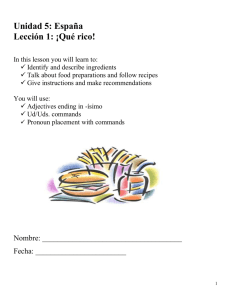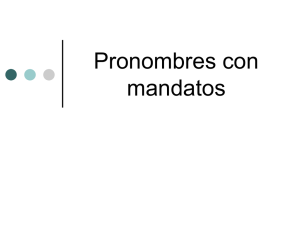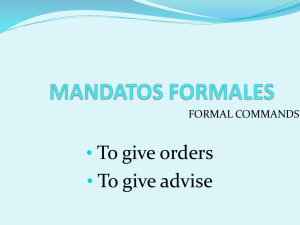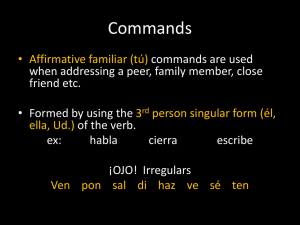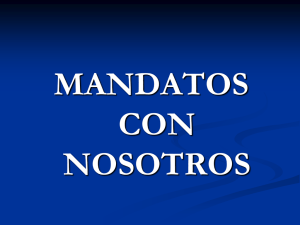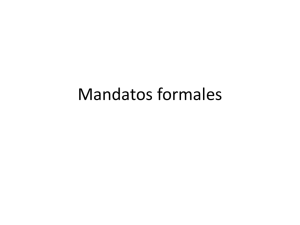Spanish Formal Commands: Ud. & Uds. Imperative Guide
advertisement
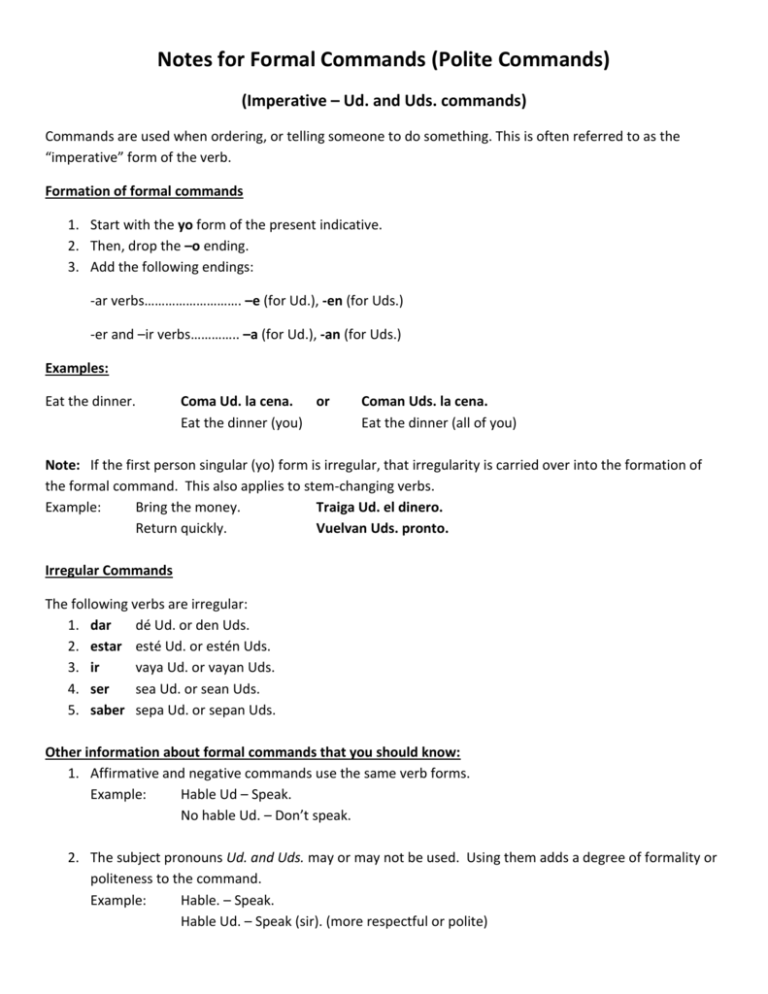
Notes for Formal Commands (Polite Commands) (Imperative – Ud. and Uds. commands) Commands are used when ordering, or telling someone to do something. This is often referred to as the “imperative” form of the verb. Formation of formal commands 1. Start with the yo form of the present indicative. 2. Then, drop the –o ending. 3. Add the following endings: -ar verbs………………………. –e (for Ud.), -en (for Uds.) -er and –ir verbs………….. –a (for Ud.), -an (for Uds.) Examples: Eat the dinner. Coma Ud. la cena. or Eat the dinner (you) Coman Uds. la cena. Eat the dinner (all of you) Note: If the first person singular (yo) form is irregular, that irregularity is carried over into the formation of the formal command. This also applies to stem-changing verbs. Example: Bring the money. Traiga Ud. el dinero. Return quickly. Vuelvan Uds. pronto. Irregular Commands The following verbs are irregular: 1. dar dé Ud. or den Uds. 2. estar esté Ud. or estén Uds. 3. ir vaya Ud. or vayan Uds. 4. ser sea Ud. or sean Uds. 5. saber sepa Ud. or sepan Uds. Other information about formal commands that you should know: 1. Affirmative and negative commands use the same verb forms. Example: Hable Ud – Speak. No hable Ud. – Don’t speak. 2. The subject pronouns Ud. and Uds. may or may not be used. Using them adds a degree of formality or politeness to the command. Example: Hable. – Speak. Hable Ud. – Speak (sir). (more respectful or polite) Using Object Pronouns with Commands – Affirmative Commands 1. In all affirmative commands, the object pronouns are attached directly to the end of the imperative form of the verb. Compre Ud. el anillo. – Buy the ring Cómprelo Ud. – Buy it. 2. If both direct and indirect object pronouns are attached, the indirect object pronoun comes before the direct object pronoun. (Remember RID (reflexive, indirect, direct) Cómprelo Ud. – Buy it. Cómpremelo Ud. – Buy it for me. Notes: a. In order to maintain the original stress of the verb, a written accent is often needed. If the command has more than one syllable, a written accent is required when one or more pronoun is added. (Ex. Command: compre (two syllables) – cómpremelos b. If the command has only one syllable, a written accent is only necessary when two pronouns are added. (Ex. Command: haz (one syllable) – hazlo (one pronoun, no accent required) – házmelo (two pronouns, accent is required) c. These rules for accentuation apply to ALL AFFIRMATIVE imperative forms. Using Object Pronouns with Commands – Negative Commands 1. With all negative commands, the object pronouns come before the imperative form of the verb. No compre Ud. el anillo – Don’t buy the ring. No lo compre. – Don’t buy it. 2. If there are both direct and indirect object pronouns, the indirect object pronoun comes before the direct object pronoun. No me lo compre. – Don’t buy it for me. 3. If you have two object pronouns that both begin with the letter “l” change the first pronoun to “se.” le lo ……..se lo le la………se la le los …….se los This rule also applies to affirmative commands le las ……..se las les lo………se lo les la …….. se la les los……. se los les las……. se las
